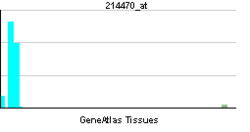KLRB1
| KLRB1 | |||||||||||||||||
|---|---|---|---|---|---|---|---|---|---|---|---|---|---|---|---|---|---|
| Identifiers | |||||||||||||||||
| Aliases | KLRB1, CD161, CLEC5B, NKR, NKR-P1, NKR-P1A, NKRP1A, hNKR-P1A, killer cell lectin like receptor B1 | ||||||||||||||||
| External IDs | MGI: 107540 HomoloGene: 84369 GeneCards: KLRB1 | ||||||||||||||||
| |||||||||||||||||
| RNA expression pattern | |||||||||||||||||
 | |||||||||||||||||
| More reference expression data | |||||||||||||||||
| Orthologs | |||||||||||||||||
| Species | Human | Mouse | |||||||||||||||
| Entrez | |||||||||||||||||
| Ensembl | |||||||||||||||||
| UniProt | |||||||||||||||||
| RefSeq (mRNA) | |||||||||||||||||
| RefSeq (protein) | |||||||||||||||||
| Location (UCSC) | Chr 12: 9.59 – 9.61 Mb | Chr 6: 128.61 – 128.62 Mb | |||||||||||||||
| PubMed search | [1] | [2] | |||||||||||||||
| Wikidata | |||||||||||||||||
| View/Edit Human | View/Edit Mouse |
Killer cell lectin-like receptor subfamily B, member 1, also known as NK1.1,KLRB1, NKR-P1A or CD161 (cluster of differentiation 161), is a human gene.[3]
Function
Natural killer (NK) cells are lymphocytes that mediate cytotoxicity and secrete cytokines after immune stimulation. Several genes of the C-type lectin superfamily, including the rodent NKRP1 family of glycoproteins, are expressed by NK cells and may be involved in the regulation of NK cell function. The KLRB1 protein contains an extracellular domain with several motifs characteristic of C-type lectins, a transmembrane domain, and a cytoplasmic domain. The KLRB1 protein, NKR-P1A or CD161, is classified as a type II membrane protein because it has an external C terminus.[3] NKR-P1A, the receptor encoded by the KLRB1 gene, recognizes Lectin Like Transcript-1 (LLT1) as a functional ligand.
References
Further reading
- Smith FB, Connor JM, Lee AJ, Cooke A, Lowe GD, Rumley A, Fowkes FG (2004). "Relationship of the platelet glycoprotein PlA and fibrinogen T/G+1689 polymorphisms with peripheral arterial disease and ischaemic heart disease". Thrombosis Research. 112 (4): 209–16. doi:10.1016/j.thromres.2003.11.010. PMID 14987913.
- Lanier LL, Chang C, Phillips JH (September 1994). "Human NKR-P1A. A disulfide-linked homodimer of the C-type lectin superfamily expressed by a subset of NK and T lymphocytes". Journal of Immunology. 153 (6): 2417–28. PMID 8077657.
- Poggi A, Costa P, Morelli L, Cantoni C, Pella N, Spada F, Biassoni R, Nanni L, Revello V, Tomasello E, Mingari MC, Moretta A, Moretta L (June 1996). "Expression of human NKRP1A by CD34+ immature thymocytes: NKRP1A-mediated regulation of proliferation and cytolytic activity". European Journal of Immunology. 26 (6): 1266–72. doi:10.1002/eji.1830260613. PMID 8647203.
- Renedo M, Arce I, Rodríguez A, Carretero M, Lanier LL, López-Botet M, Fernández-Ruiz E (1997). "The human natural killer gene complex is located on chromosome 12p12-p13". Immunogenetics. 46 (4): 307–11. doi:10.1007/s002510050276. PMID 9218532.
- Poggi A, Costa P, Zocchi MR, Moretta L (September 1997). "Phenotypic and functional analysis of CD4+ NKRP1A+ human T lymphocytes. Direct evidence that the NKRP1A molecule is involved in transendothelial migration". European Journal of Immunology. 27 (9): 2345–50. doi:10.1002/eji.1830270932. PMID 9341779.
- Poggi A, Rubartelli A, Moretta L, Zocchi MR (November 1997). "Expression and function of NKRP1A molecule on human monocytes and dendritic cells". European Journal of Immunology. 27 (11): 2965–70. doi:10.1002/eji.1830271132. PMID 9394825.
- Poggi A, Costa P, Tomasello E, Moretta L (May 1998). "IL-12-induced up-regulation of NKRP1A expression in human NK cells and consequent NKRP1A-mediated down-regulation of NK cell activation". European Journal of Immunology. 28 (5): 1611–6. doi:10.1002/(SICI)1521-4141(199805)28:05<1611::AID-IMMU1611>3.0.CO;2-6. PMID 9603467.
- Carlyle JR, Martin A, Mehra A, Attisano L, Tsui FW, Zúñiga-Pflücker JC (May 1999). "Mouse NKR-P1B, a novel NK1.1 antigen with inhibitory function". Journal of Immunology. 162 (10): 5917–23. PMID 10229828.
- Ishihara S, Nieda M, Kitayama J, Osada T, Yabe T, Ishikawa Y, Nagawa H, Muto T, Juji T (August 1999). "CD8(+)NKR-P1A (+)T cells preferentially accumulate in human liver". European Journal of Immunology. 29 (8): 2406–13. doi:10.1002/(SICI)1521-4141(199908)29:08<2406::AID-IMMU2406>3.0.CO;2-F. PMID 10458753.
- Iiai T, Watanabe H, Suda T, Okamoto H, Abo T, Hatakeyama K (July 2002). "CD161+ T (NT) cells exist predominantly in human intestinal epithelium as well as in liver". Clinical and Experimental Immunology. 129 (1): 92–8. doi:10.1046/j.1365-2249.2002.01886.x. PMC 1906419
 . PMID 12100027.
. PMID 12100027. - Iizuka K, Naidenko OV, Plougastel BF, Fremont DH, Yokoyama WM (August 2003). "Genetically linked C-type lectin-related ligands for the NKRP1 family of natural killer cell receptors". Nature Immunology. 4 (8): 801–7. doi:10.1038/ni954. PMID 12858173.
- Carlyle JR, Jamieson AM, Gasser S, Clingan CS, Arase H, Raulet DH (March 2004). "Missing self-recognition of Ocil/Clr-b by inhibitory NKR-P1 natural killer cell receptors". Proceedings of the National Academy of Sciences of the United States of America. 101 (10): 3527–32. doi:10.1073/pnas.0308304101. PMC 373496
 . PMID 14990792.
. PMID 14990792. - Aldemir H, Prod'homme V, Dumaurier MJ, Retiere C, Poupon G, Cazareth J, Bihl F, Braud VM (December 2005). "Cutting edge: lectin-like transcript 1 is a ligand for the CD161 receptor". Journal of Immunology. 175 (12): 7791–5. doi:10.4049/jimmunol.175.12.7791. PMID 16339512.
- Rosen DB, Bettadapura J, Alsharifi M, Mathew PA, Warren HS, Lanier LL (December 2005). "Cutting edge: lectin-like transcript-1 is a ligand for the inhibitory human NKR-P1A receptor". Journal of Immunology. 175 (12): 7796–9. doi:10.4049/jimmunol.175.12.7796. PMID 16339513.
- Pozo D, Valés-Gómez M, Mavaddat N, Williamson SC, Chisholm SE, Reyburn H (February 2006). "CD161 (human NKR-P1A) signaling in NK cells involves the activation of acid sphingomyelinase". Journal of Immunology. 176 (4): 2397–406. doi:10.4049/jimmunol.176.4.2397. PMID 16455998.
- Christiansen D, Mouhtouris E, Milland J, Zingoni A, Santoni A, Sandrin MS (September 2006). "Recognition of a carbohydrate xenoepitope by human NKRP1A (CD161)". Xenotransplantation. 13 (5): 440–6. doi:10.1111/j.1399-3089.2006.00332.x. PMID 16925668.
- Rosen DB, Cao W, Avery DT, Tangye SG, Liu YJ, Houchins JP, Lanier LL (May 2008). "Functional consequences of interactions between human NKR-P1A and its ligand LLT1 expressed on activated dendritic cells and B cells". Journal of Immunology. 180 (10): 6508–17. doi:10.4049/jimmunol.180.10.6508. PMC 2577150
 . PMID 18453569.
. PMID 18453569.
This article incorporates text from the United States National Library of Medicine, which is in the public domain.